Source: Glassnode ; Translated by: AIMan@ Jinse Finance
summary:
The macroeconomic environment remains uncertain as global trade relations continue to restructure. This uncertainty has heightened volatility in both the U.S. Treasury and equity markets.
Faced with dire economic conditions, Bitcoin has recorded its largest drop so far this cycle. Nevertheless, this is still within the typical range of previous corrections during bull markets . Moreover, the median drop in this cycle is still an order of magnitude lower than in the past, highlighting its more resilient demand profile.
Liquidity across the digital asset ecosystem continues to tighten, reflected in declining capital inflows and stagnant stablecoin growth .
Investors are under tremendous pressure and are currently facing their largest unrealized losses ever. However, these losses are concentrated among new investors, while long-term holders generally remain profitable.
Macro uncertainty remains widespread
The macroeconomic landscape is permeated with great uncertainty, and the Trump administration is trying to upend and restructure the status quo of global trade relations. Currently, U.S. Treasury bonds are the collateral and foundation of the financial system, and the 10-year U.S. Treasury bond is regarded as the benchmark risk-free rate.
A key government goal was to lower the 10-year Treasury yield, which had some initial success in the first few months of the year, with yields falling to 3.7% as markets sold off. However, that goal was short-lived, with yields subsequently surging to 4.5%, erasing that progress and causing huge volatility in the bond market.
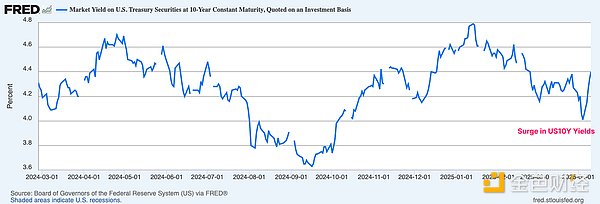
Source: FRED
We can quantify disorderly behavior in the bond market using the MOVE index, a key measure of bond market stress and volatility based on the implied 30-day volatility of the U.S. Treasury market based on option prices of different maturities.
By this measure, volatility in U.S. Treasuries has risen sharply, highlighting the extreme uncertainty and panic among bond market investors .
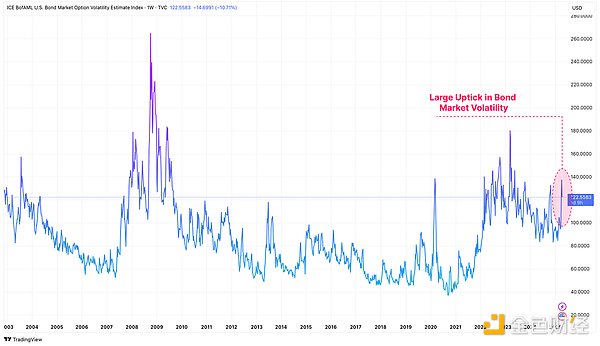
Source: Tradingview
We can also measure the volatility of the US stock market using the Volatility Index (VIX), which measures the market's expectations of 30-day volatility in the US stock market. Volatility in the bond market is also significantly reflected in the stock market, and the volatility values currently recorded by the VIX are similar to those during the 2020 COVID crisis, the 2008 global financial crisis, and the 2001 Internet bubble.
Fluctuations in the underlying collateral of the financial system often lead to a withdrawal of investor capital and tightening of liquidity conditions. Given that Bitcoin and digital assets are among the most liquidity-sensitive instruments, they are naturally affected by volatility and risk asset drawdowns.
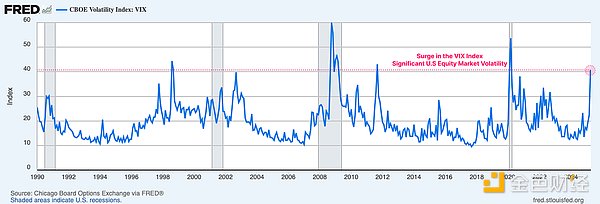
Source: FRED
Hard assets have continued to perform impressively amid this volatility. Gold prices have continued to surge, hitting new highs of $3,300 as investors flock to traditional safe havens. Bitcoin initially sold off along with risk assets to $75,000, but has since recovered its gains for the week, rising back to $85,000 and is currently trading flat since this volatility outbreak.
As the world adjusts to changing trade relations, gold and Bitcoin are increasingly taking center stage as neutral global reserve assets. Therefore, it can be said that gold and Bitcoin showed an interesting signal in their movements last week.
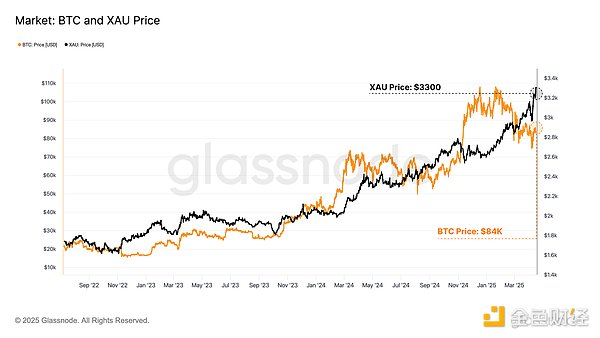
Bitcoin remains strong
While Bitcoin is still trading in the $85,000 region, which is impressive, the leading digital asset has still seen heightened volatility and retracements in recent months. The asset has seen its biggest drop since the 2023-25 cycle, with the largest retracement falling 33% from its all-time high.
However, the decline is still within the typical range of previous pullbacks during bull markets. In previous macroeconomic events such as last week, Bitcoin has often experienced sell-offs of more than 50%, highlighting that modern investor sentiment towards the asset remains somewhat robust in adverse environments .

To quantify the resilience of the current cycle, we can assess the rolling median retracement of all bull market structures .
2011: -22%
2011-2013: -18%
2015-2018: -11%
2018-2021: -19%
2022 and beyond: -7%
The median retracement in the current cycle has been much smaller than all previous ones. Since 2023, retracements have been smaller and more controlled in nature, suggesting that demand conditions are more resilient and that many Bitcoin investors are more willing to hold on during market turmoil.
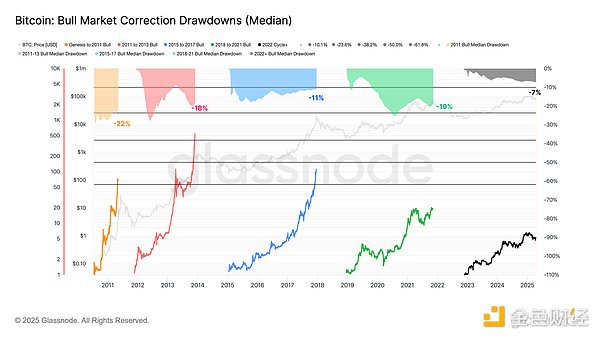
Liquidity continues to shrink
We can also assess how macro uncertainty affects Bitcoin’s liquidity profile.
We can measure Bitcoin’s internal liquidity through the realized market cap metric, which calculates the cumulative net inflow of capital into a digital asset. Realized market cap is currently trading at an all-time high of $872 billion, however, capital growth has compressed to just +0.9% per month.
In a very challenging market environment, it is impressive that capital inflows into the asset class have remained positive. Given that the rate at which new capital is flowing into the asset class is slowing, this also suggests that investors are currently less willing to deploy capital in the short term, which means that risk aversion is likely to remain the default behavior for now.
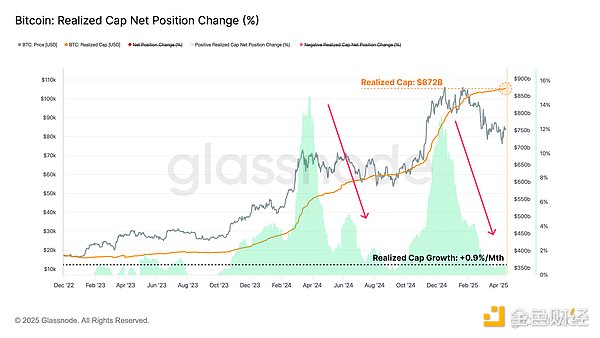 The realized profit and loss metric is an input component of realized market cap, allowing us to measure the difference between a token’s acquisition price and its value when used on-chain.
The realized profit and loss metric is an input component of realized market cap, allowing us to measure the difference between a token’s acquisition price and its value when used on-chain.
Tokens held above the acquisition price are considered to lock in realized profits.
Tokens below the purchase price are considered locked-in realized losses.
By measuring realized PNL in BTC, we can normalize all profit and loss events against the expanding market cap over Bitcoin cycles. Here, we introduce a new variable and further refine it by adjusting for volatility (7-day realized volatility) that helps explain the diminishing returns and diminishing growth rates that Bitcoin has experienced as it matures over its 16-year history.
Currently, profit-taking and loss-making activity is relatively balanced, which has led to the relatively neutral capital inflow rate mentioned earlier. It can be said that this reflects the saturation of investor activity within the current price range and usually precedes a period of consolidation as the market tries to find a new equilibrium point.
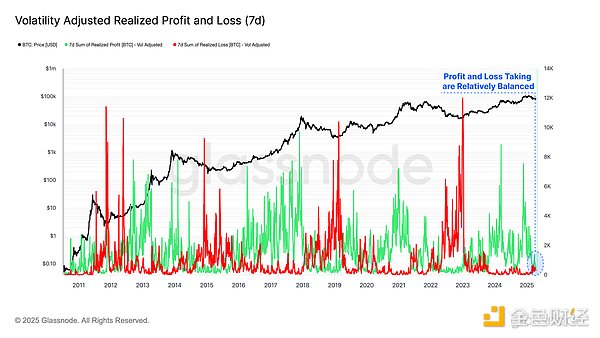
By calculating the difference between realized profits and realized losses, we can derive the net realized profit/loss metric, which measures the direction of value flow into/out of the network.
Using the volatility-adjusted net realized profit/loss metric, we can compare it to the cumulative median to distinguish between the two market regimes.
Values consistently above the median usually signal a bull market and net capital inflows.
Sustained values below the cumulative median are generally considered a bear market, and Bitcoin will experience net capital outflows.
Markets often push investors to the brink of extreme pain, usually peaking at turning points in bull and bear cycles. We can see that volatility-adjusted net realized P&L fluctuates around its long-term median, acting as a mean-reversion tool.
The indicator has now reset back to its neutral median, suggesting that the Bitcoin market is now at a critical decision point and drawing a line for bulls to re-establish support in the current price range .
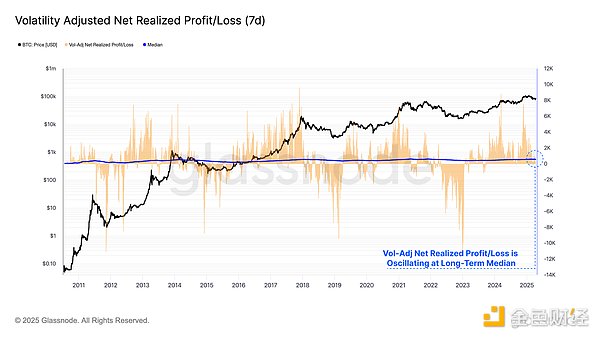
Stablecoins have become a fundamental asset class in the digital asset ecosystem, acting as quoted assets in centralized and decentralized trading platforms. Assessing liquidity through the lens of stablecoins provides a new dimension to our analysis, allowing us to gain a more comprehensive understanding of the liquidity status of digital assets.
Stablecoin supply growth remains positive but has slowed in recent weeks, further suggesting that broader digital asset liquidity is shrinking, as evidenced by weakening demand for the digital native dollar.
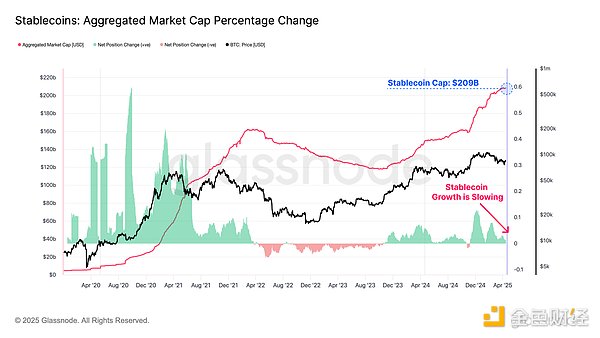
Investor pressure
Amid the ongoing market turmoil, it is important to assess the scale of unrealized losses currently held by Bitcoin investors.
When measuring the unrealized losses held by the market, we note that during the market’s decline to $75,000, unrealized losses reached a new high of $410 billion. When we examine the composition of unrealized losses, we can see that most investors are holding drawdowns as high as -23.6%.
The total unrealized losses are larger compared to the May 2021 sell-off and the 2022 bear market. However, it is worth noting that for individual investors, the market experienced more dramatic declines, as high as -61.8% and -78.6%, respectively.
While total unrealized losses are larger (given that Bitcoin is now a much larger asset), individual investors face less challenges today than during previous bear market periods.
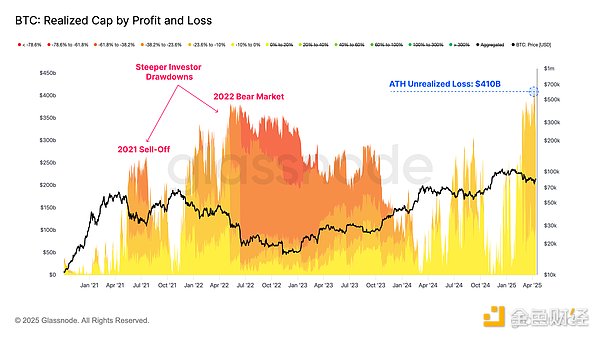
Despite the record high unrealized losses held, the percentage of profitable positions in the circulating supply is still as high as 75%. This shows that most of the losing investors are new buyers after the top formation.
It is worth noting that the percentage of supply in profit is approaching its long-term average. Historically, this is a critical area to defend before the vast majority of cryptocurrencies fall into losses and is a key threshold between bull and bear market structures.
Bull markets are typically characterized by earnings supply above its long-term average, and this level will usually find support across the market.
Historically, bear markets are often accompanied by deep and prolonged periods below the long-term mean, while frequent declines below this level confirm declining profitability.
Similar to the net realized profit/loss metric, a bounce back above the long-term average range would be a positive observation if it can be held.
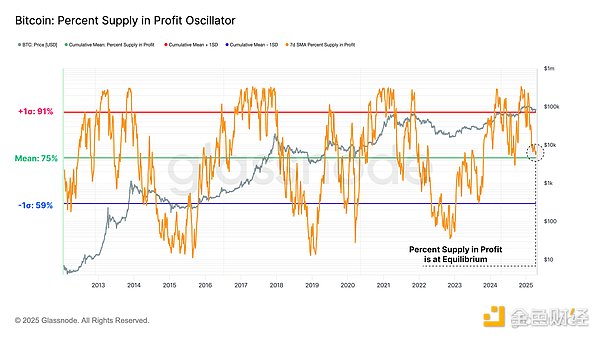
As the market continues to shrink, it is reasonable to expect the absolute size of unrealized losses to increase. To account for this phenomenon and normalize for drawdowns of varying magnitude, we introduce a new indicator variable: unrealized losses per percentage drawdown, which represents the percentage drop in losses in Bitcoin relative to the all-time high.
Applying this metric to the short-term holder group shows that their unrealized losses after the deep drawdown correction have been substantial, comparable to levels seen at the start of previous bear markets.
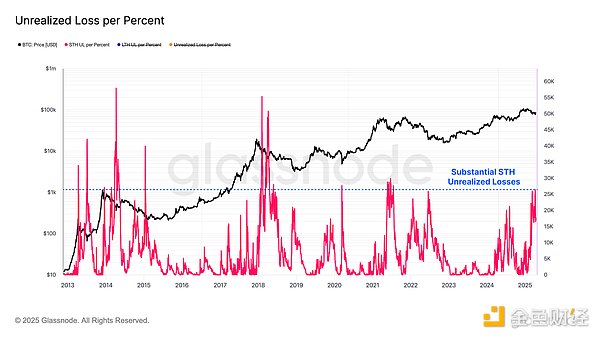
Still, the current unrealized losses are concentrated among new investors, while long-term holders remain in a one-sided profit . However, an important nuance is emerging: as recent top buyers gradually become long-term holders, the level of unrealized losses for this group may rise.
Historically, a sharp increase in unrealized losses among long-term holders has often signaled the confirmation of bear market conditions, albeit with a delay after the market has peaked. So far, there is no clear evidence that this shift in pattern is occurring.
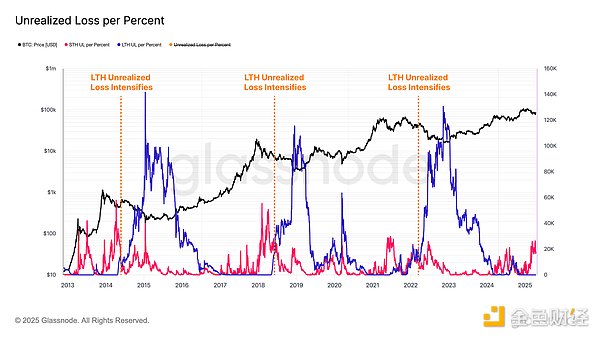
Summary and Conclusion
The macroeconomic landscape remains uncertain, and the global trade landscape continues to change, leading to significant volatility in the U.S. Treasury and stock markets. It is worth noting that Bitcoin and gold have performed particularly strongly, especially during this challenging period. This may be an encouraging sign as the foundations of the financial system enter a period of transformation and change.
Despite its remarkable resilience, Bitcoin has not been immune to the sharp volatility in global markets, recording its biggest drop since the 2023-2025 cycle. This has greatly affected new market participants, who are currently bearing the lion's share of market losses. However, from the perspective of individual investors, the market has experienced more severe declines in previous cycles, especially during the bear market in May 2021 and 2022. In addition, mature and long-term investors have remained unperturbed by the ongoing economic pressures and are almost in a state of unilateral profit.







